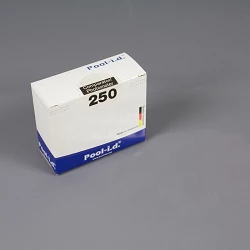Glycine Photometer Reagent PrimeLAB (250 tablets)

- Glycine reagent.
- For photometer.
- Format: box with 250 tablets.
- Individually sealed to ensure exact dosage and long shelf life.
- Necessary for the measurement of:
- Bromine
- Chlorine dioxide
- Ozone
Bought together Usually
Technical characteristics
PrimeLab Glycine Reagent
- Glycine reagent.
- For photometer.
- Format: box with 250 tablets.
- Individually sealed to ensure accurate dosing and long shelf life.
- Necessary for the measurement of:
- Bromine
- Chlorine dioxide
- Ozone
Bromine measurement
The use of bromine as a disinfectant is an increasingly popular alternative to chlorine. This method has the advantage that combined bromine, in contrast to combined chlorine (= chloramine), is odourless, i.e. despite its identical disinfectant effect, it does not irritate the mucous membranes of the human skin. The disadvantages of the use of bromine products are, however, the low oxidative effect, the high price and the risks involved in handling them. Often a combination of bromine and chlorine is used, which makes it difficult to measure the concentration. The measurement according to DPD method No. 1 therefore provides (if chlorine is used at the same time as bromine) a total concentration of free and combined bromine as well as free chlorine. In order to be able to determine the pure bromine concentration in this special case, it is necessary to convert the free chlorine into combined chlorine by means of DPD glycine (tablet or powderpack). In contrast to chlorine, DPD reagent no. 1 reacts with both free bromine and combined bromine and therefore always records total bromine.
Chlorine Dioxide Measurement
Chlorine dioxide (2.33 times heavier than air) is a gaseous bond between halogen chlorine and oxygen (ClO2) which, compared to pure chlorine, has the advantage of being less perceptible in odour and taste, as well as acting as a virus exterminator. Chlorine dioxide is created in special installations close to the place of consumption by a combination of chlorine gas or underchlorinated acid and a solution of liquid sodium chlorite (NaClO2) in a ratio of 10:1. As minimum/maximum values 0.05 mg/l - 0.2 mg/l on average is acceptable.
Ozone measurement
Ozone consists of 3 oxygen atoms (O3). It is an unstable molecule and decomposes both in air and dissolved in water in a very short time to oxygen O2 and an oxygen radical. The oxidative action of this oxygen radical is extremely powerful, although a delayed effect is ruled out, as two radicals combine immediately to form O2. Ozone is created directly on site by means of an ozone generator and other necessary equipment. Ozone is 10 times more poisonous than chlorine, so there are special rules and precautionary measures. Thus, ozone is only used within a dosage range (outside the pool) and must be filtered before re-entry (active carbon). The maximum permissible concentration of ozone reintroduced into the pool is only 0.05 mg/l, so ozone alone is not sufficient disinfectant and must be supplemented by other disinfectants (usually chlorine). Ozone kills germs, oxidises organic impurities (e.g. urea), reduces the consumption of chlorine in the pool and leaves no unpleasant traces. Generally, the human sense of smell, which is capable of detecting ozone concentrations of 1:500,000, is the best measuring instrument. However, ozone can also be measured together with chlorine using the DPD method. By adding glycine, ozone is removed so that only chlorine can be measured and ozone is obtained by calculating the difference.
Data Sheet
- Format
- Tablets
- Type of case
- Reagents
- Number of tests
- 250










